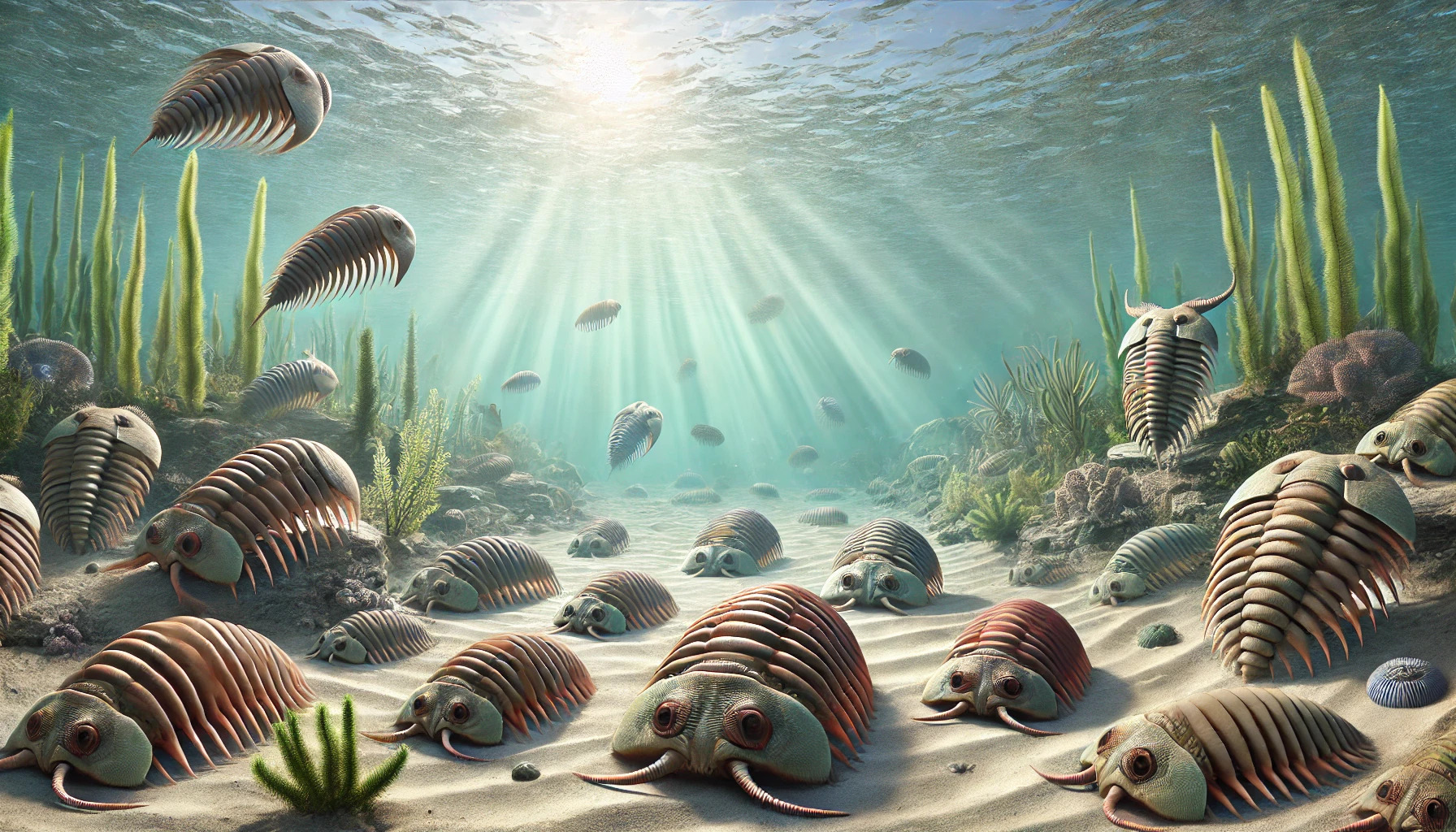Trilobites were fascinating marine creatures that roamed the oceans for over 250 million years. These ancient arthropods are known for their unique three-lobed body structure, which made them one of the earliest complex life forms on Earth. Their history spans several geological periods, making them important to paleontological studies.
These incredible animals thrived in oceans long before dinosaurs appeared. They had a variety of shapes and sizes, which allowed them to adapt to different environments. As a result, trilobites left behind a rich fossil record that helps scientists understand the evolution of life on our planet.
Exploring the world of trilobites reveals much about the Earth’s past and the challenges life faced over millions of years. The story of these creatures is not just about extinction; it’s also about resilience and diversity through the ages. The more one learns about trilobites, the more they appreciate the complexity of ancient life.
Trilobite Origins and Evolution
Trilobites have a fascinating history that spans hundreds of millions of years. Their origins, development, and the events that led to their extinction reveal much about their adaptability and diversity in ancient oceans.
Early Development
Trilobites first appeared in the fossil record during the Cambrian Period, around 521 million years ago. They are believed to have evolved from earlier, soft-bodied organisms that may resemble modern-day arthropods. Fossils like those found in Australia hint at these early forms with segmented bodies, showcasing the transition from simple to more complex structures.
Their unique exoskeleton and jointed limbs helped them thrive in various marine environments. These adaptations enabled trilobites to become one of the earliest successful groups of animals.
Diversification
As trilobites evolved, they rapidly diversified into thousands of species. This took place mainly during the Ordovician and Silurian periods. They occupied different ecological niches, from shallow seas to deep ocean floors.
Trilobites displayed a wide range of sizes and shapes. Some had long, slender bodies, while others were more robust. This diversity allowed them to survive various environmental changes and compete with emerging predators. Their adaptability was key to thriving during the Paleozoic Era.
Extinction Event
Despite their success, trilobites faced significant challenges. They endured several extinction events, including the Late Devonian and the most notable, the Permian-Triassic extinction around 252 million years ago.
This event wiped out about 90% of Earth’s species, including many trilobite groups. After this catastrophe, trilobites could not recover their former diversity. By the end of the Triassic period, they had completely disappeared, marking the end of an era for these ancient creatures.
Physical Characteristics
Trilobites had unique physical features that made them stand out in the ancient oceans. Their body structure, sensory capabilities, and limb formations were key to their survival and adaptation.
Exoskeleton and Segmentation
Trilobites are known for their hard exoskeleton, which provided protection and support. This outer shell was composed of chitin and calcium carbonate, making it tough yet lightweight.
Their bodies were segmented into three main parts: the cephalon (head), thorax (body), and pygidium (tail). Each segment allowed flexibility and movement. The thorax often had multiple segments, which helped trilobites curl up when threatened.
Some fossil records show intricate patterns and textures on their exoskeletons, indicating adaptations to their environments. These features helped scientists classify the various trilobite species based on their designs.
Facial Sutures and Eyes
Trilobites had distinctive facial sutures that divided the front of their head. These lines allowed for greater movement of the compound eyes without damaging the exoskeleton.
Their eyes were remarkably advanced for their time. Some trilobites had large, well-developed eyes that could detect light and movement. This helped them locate prey and avoid predators in their deep-sea habitats.
The placement and shape of the eyes varied between species, showcasing evolutionary adaptations. Some had eyes on stalks, enhancing their ability to see threats and food from different angles.
Legs and Appendages
Trilobites had jointed legs and appendages that helped them move through the water and interact with their environment.
Most trilobites had several pairs of legs attached to their thorax. These legs were often specialized for different functions, such as walking, swimming, or even digging.
Trilobites also had antennae, which were crucial for sensing their surroundings. This combination of legs and sensory appendages allowed trilobites to navigate their environments skillfully. They could hunt for food or escape from predators with agility.
Classification and Taxonomy
Trilobites possess a fascinating classification system that reflects their evolutionary history. Understanding their order distinctions and how species are identified is crucial for anyone interested in these ancient creatures.
Order and Family Distinctions
Trilobites are divided into several orders based on shared features. The major orders include Ptychopariida, Phacopida, and Asaphida. Each order contains various families that showcase distinct traits.
For instance, the Ptychopariida order is known for its complex eye structures and varied body shapes. In contrast, the Phacopida often displays highly developed eyes and a distinctive morphology. Features like the number of segments and type of cephalon help paleontologists distinguish between families and orders.
Species Identification
Identifying trilobite species can be challenging due to their diversity. Researchers examine specific traits, such as shell shape, size, and the arrangement of facial features. Triangulating this information can lead to identifying a particular species.
For example, the Olenoides family may be recognized by its long, oval body and well-defined segments. Morphological features, such as the arrangement of spines and the presence of specific structures, are equally important for identification.
Additionally, fossil locations provide context for understanding species. Trilobites adapted to different environments, making habitat information a helpful tool in classification.
Fossil Record
Trilobites have an extensive fossil record that provides insights into their evolution and history. Their well-preserved remains are found in many locations around the world, showcasing their diversity.
Preservation and Discovery
Trilobites are known for their hard exoskeletons, which helped them become excellent candidates for fossilization. When they died, their bodies often settled on the sea floor, becoming buried by sediment. Over time, minerals replaced the organic materials, resulting in stunning fossils.
Fossils can range from complete specimens to fragments of their shells. Paleontologists often discover these fossils in sedimentary rock layers that date back to the Paleozoic era. Many trilobite fossils exhibit details like compound eyes and intricate markings, showcasing their complex structure.
Distribution of Fossils
Trilobite fossils have been discovered on every continent, highlighting their widespread presence during their time on Earth. They thrived in various marine environments, from shallow coastal waters to deeper ocean floors.
The most abundant fossils come from regions that were once covered by oceans. Some areas, like the Burgess Shale in Canada, have yielded exceptional trilobite fossils. These finds allow scientists to study their adaptations and interactions in ancient ecosystems. Fossil records reveal numerous species, making trilobites one of the best-known groups of extinct organisms.
Ecology and Behavior
Trilobites were diverse creatures with unique habitats and behaviors, showcasing their adaptability in ancient marine environments. Their ways of living and feeding provide insight into their role in the ecosystem.
Habitats and Lifestyle
Trilobites lived in various marine habitats. They were often found in shallow waters, like coastal areas and continental shelves. Some species thrived in deeper ocean floors, adapted to different conditions.
These creatures inhabited environments ranging from muddy to sandy substrates. Their body structure allowed them to move effectively across these terrains. Some trilobites were free-roaming, while others likely burrowed into the ocean floor for shelter or feeding.
Feeding Habits
Trilobites had diverse feeding habits, influenced by their environment. Many species were scavengers, feeding on dead organisms. Others were likely predators, hunting smaller marine creatures.
Their mouthparts, called gnathobases, were well-suited for grinding food. Some trilobites had specialized structures to filter small particles from the water, indicating a varied diet.
This adaptability allowed trilobites to thrive in various ecological niches. They played a vital role in maintaining the balance of ancient marine ecosystems.
Trilobite Research and Studies
Trilobite research has made significant strides over the years. Recent studies have revealed new insights into their biology and evolution, thanks to advances in technology and methodology.
Significant Discoveries
Researchers have uncovered remarkable findings about trilobites. One key discovery involved a 465-million-year-old trilobite fossil that provided crucial details about its diet. Examination of gut contents showed what these ancient creatures ate and how they consumed their food.
Another notable find involved a detailed analysis of trilobite features, leading to a better understanding of their anatomy. These studies help clarify long-standing debates about their lifestyle and ecological role in ancient environments.
Additionally, the identification of new trilobite species continues, expanding knowledge of their diversity. For instance, researchers at the American Museum of Natural History discovered unique specimens that challenged previous classifications.
Technological Advancements in Study
Modern technology plays a vital role in trilobite research. Techniques such as high-resolution imaging and 3D modeling allow scientists to study fossils in unprecedented detail. These methods help reveal features that are not visible to the naked eye.
Moreover, biostratigraphy is now used to analyze fossil layers more accurately. By understanding the distribution of trilobites in different geological periods, researchers can better track evolutionary changes.
The use of digital databases has also transformed how research is conducted. Scientists can easily share and access information about trilobite specimens, enhancing collaboration and speeding up discoveries.
These advancements are vital for understanding the complex history of these fascinating creatures.
Cultural and Historical Significance
Trilobites hold a unique place in both indigenous cultures and modern scientific study. Their fascinating history and distinct forms have inspired curiosity and appreciation in many spheres of life.
Trilobites in Indigenous Cultures
Trilobites have appeared in various indigenous cultures, often symbolizing resilience and adaptation. For some communities, these ancient creatures represent a connection to the earth’s history, enduring through time.
Artifacts have been found that suggest ancient peoples interacted with trilobite fossils. For example, in North America, fossilized remains may have inspired myths and stories, reflecting the relationship between humans and the natural world.
Today, these connections are celebrated in educational programs that honor local heritage while teaching about geology and paleontology. By linking trilobites to cultural narratives, tribes foster a deeper respect for the natural history surrounding them.
Impact on Modern Science and Education
Trilobites have played a significant role in advancing the field of paleontology. Their well-preserved fossils help scientists understand the evolution of life on Earth. By studying trilobites, researchers can gain insight into ancient environments and the changes that occurred over millions of years.
In the classroom, trilobites serve as important educational tools. They help engage students in topics like evolution, geology, and environmental science. Museum displays and fossil exhibits create interactive learning experiences that spark curiosity in young minds.
Science festivals and community events also highlight trilobites, fostering an interest in paleontology. These activities encourage exploration and discovery, showing how ancient life forms can help shape understanding of the present and future.

